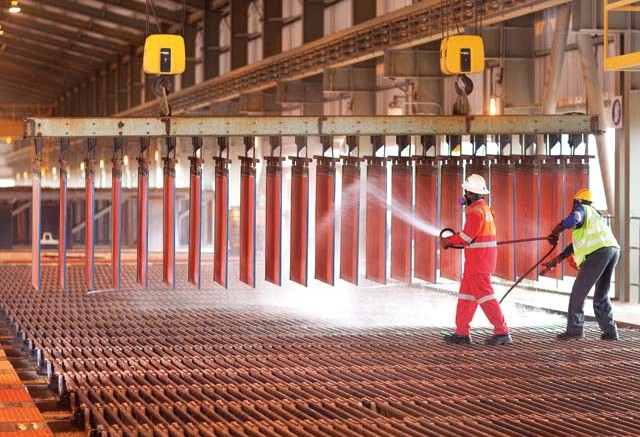These are interesting times for copper investors. Concerns on the supply side, questions over sustained demand due to sluggish global economic growth and a forward curve that defies the normal contango situation are some of the major issues that copper-market watchers are trying to get their heads around.
The supply and demand situation is best captured by the shape of the forward curve, which has been in backwardation for months. That backwardation only widened in late May on growing concerns about supply issues and is expected to stay in place for a while due to dwindling inventories and a concentration of copper ownership in China.
Backwardation occurs when the forward price of copper is lower than the spot price. Under normal conditions the price of the forward contract is expected to be higher than the spot price to reflect costs associated with holding the metal until the future delivery date — a situation which is known as “contango.”
Backwardation most commonly occurs when supply issues cause a surge in what is known as the “convenience yield.” As opposed to a cost associated with holding the metal, a convenience yield is a benefit to holding the metal, and is generally accrued to entities that have use of the metal and value holding it in their own inventory, as opposed to trusting that they can buy it at the right price later.
Since the convenience yield is a benefit as opposed to a cost to the holder of the metal, it results in the forward price being reduced so much that it falls below the spot price and into backwardation.
Market watchers are expecting that the current backwardation will “flare out,” meaning the gap between the spot and the future price will widen further, since inventories are low in the West and much of the physical metal is being stored in China, with little expected to come into the market in the coming months.
Adding to supply tightness, South Korea’s LS Nikko Copper has halted operations at its First Copper Smelter in Ulsan, South Korea. The company’s Second Copper Smelter was already suspended a few weeks earlier due to an explosion that injured eight people.
Problems at the First Copper Smelter began after a fire in the cooling tower that was connected to its smelting operation. The facility is under investigation, and the company doesn’t know how long the shutdown will last. The smelter has an annual capacity of 200,000 tonnes of refined copper — the same as its Second Copper Smelter.
Further out, the supply picture doesn’t get much rosier, as Chilean President Michelle Bachelet is strengthen glacier protection in areas where big miners such as Anglo American and Codelco had been planning to expand copper mine operations.
The country is going through its fourth year of drought, and that has heightened sensitivities to water issues and underscored the competing interests for this scarce resource.
Bachelet calls glaciers a freshwater resource of “incalculable value,” and seems to be against Codelco’s plan to remove six glaciers as part of its Andina copper mine expansion.
Anglo American’s planned Los Bronces expansion, which neighbours Andina, is also in doubt.
The companies are feeling the same heat that Barrick Gold experienced before it suspended work at its US$8.5-billion Pascua-Lama gold project due to claims mine development could seriously damage the local water supply.
A recent article in the Wall Street Journal argues that the water battles in Chile could become the norm for copper miners worldwide, as the metal is often found in large quantities in arid regions where fresh water is prized.
The article points to an unusual acquisition by Freeport-McMoRan Copper & Gold two years ago as both a sign of the company’s prescience and as a harbinger for other miners.
Freeport paid US$1.3 million to rancher Richard Kaler for 1.13 sq. km of land in the Arizona desert with no copper potential but with fresh water rights needed to expand production at its Morenci copper mine.
According to Moody’s Investors Service mining companies spent US$12 billion on water management last year, or triple what they spent just four years ago.
One solution the Chilean government is looking towards is the Pacific Ocean. The government wants miners to build desalinization plants on the coast so they can use ocean water in their mining operations.
BHP Billiton has agreed, and along with its partners in the country, it plans to build a US$3.4-billion desalinization plant for its Atacama copper mine.
Such concerns on the supply side have conspired to create a bit of resurgence in the spot copper price since its steep sell-off in March. Since April the metal’s price has climbed 9%. It traded for US$3.16 per lb. on May 23.


You know, of course, that copper is normally in backwardation, right?